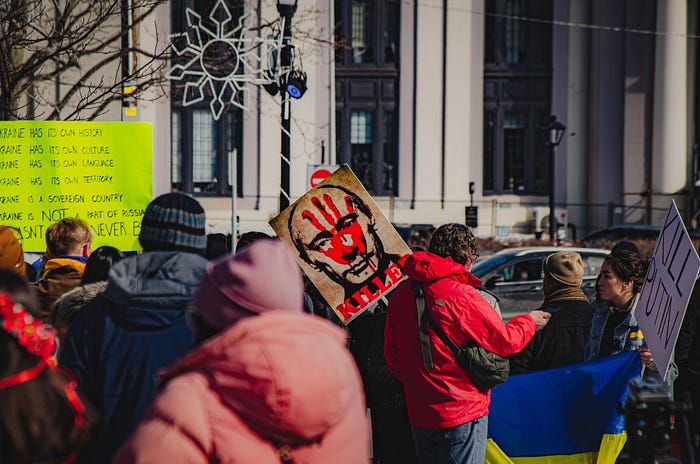While Ukraine’s military struggle continues, Russian propagandists are undermining Ukraine, and NATO, in a hundred different ways.

As the conflict in Ukraine reaches its year-and-a-half point, world leaders, politicians on three continents, media outlets, and foreign policy experts, continue to watch nervously.
While plenty of authorities agree that Russian President Vladimir Putin has to be stopped — somehow — no consensus exists for how that might be accomplished.
Sanctions haven’t done much good, thus far. Countries like China and India bought all the cheap Russian energy the U.S. and E.U. nations eschewed for the sake of democracy — and then some.
No amount of international censure seems to penetrate the conscience of Vladimir Putin, so more of that isn’t likely to work. But NATO nations, the United States chief among them, are reluctant to pursue any solution involving direct military action.
Of course, plenty of countries, including the U.S., have eventually been dragged into military conflicts they had no intention of joining.
Crimes against humanity are like other violent crimes. Once the violence begins, no one knows what might happen. Escalation is unpredictable. Violence is gunpowder plus rocket fuel. Anything can happen.
When we study history in retrospect, the path to war is clear; the path to war is less clear in real life. The U.S. might already be on a crash course with one.
Understanding the history of Ukraine, and its complex relationship with Russia is key to understanding the role of the United States and NATO in this conflict.
The history between Russia and Ukraine is characterized by a mixture of shared cultural ties and deep-rooted divisions, often exacerbated by political interests and historical events.
Since Vladimir Putin came to power in Russia in 1999, the relationship between Russia and Ukraine has been marred by conflict.
In the early years of Putin’s presidency, relations between Russia and Ukraine were relatively stable, and, outwardly, there were efforts to build economic and political ties. The two countries signed a key treaty, dedicated to cooperation and friendship early in Putin’s tenure.
The 2004 Ukrainian presidential election, which was marred by allegations of fraud, led to the Orange Revolution. Viktor Yushchenko emerged as the pro-Western leader. Russia was accused of supporting Yushchenko’s opponent, Viktor Yanukovych, which strained relations between the two countries.
In 2010, Viktor Yanukovych was elected president. His administration initially sought closer ties with Russia, which led to the shelving of a planned association agreement with the European Union (EU).
In late 2013, Yanukovych’s decision to abandon the EU agreement in favor of closer ties with Russia sparked the Euromaidan protests. The protests grew into a broader movement for democratic reforms and closer ties with the West.
The Ukrainian crisis escalated in 2014 when Yanukovych fled the country, and Russia annexed Crimea following a disputed referendum. Though the move was widely condemned by the international community, Putin got away with it.
Following the annexation of Crimea, pro-Russian separatist movements emerged in Eastern Ukraine, particularly in the Donbas region. A conflict erupted between Ukrainian government forces and separatist groups. Russia was accused of providing support to the separatists, including military equipment and personnel. The conflict resulted in significant loss of life and displacement of civilians.
Multiple attempts at ceasefires and negotiations were made, but a lasting resolution remained elusive.
Since 2014, and probably before, Russia has been engaged in a complex, multi-pronged game of information warfare against Ukraine. Putin’s aims — undermining Ukraine’s government, election tampering, propaganda, disinformation campaigns, et al — were always to soften Ukraine for invasion.
One of the primary ways Russia attacked Ukraine, was with propaganda campaigns designed to prevent Ukraine from seeking or accepting NATO membership.
Russia has consistently portrayed NATO’s expansion as a direct threat to its national security. Russian media and officials have argued that the alliance’s presence near Russia’s borders poses a risk to its sovereignty and interests.
Russian propaganda often portrays NATO as an aggressive and expansionist organization that aims to encircle and contain Russia. This narrative is designed to fuel public opposition to NATO and to create skepticism about its intentions.
Russia has spread disinformation and false narratives to create confusion and undermine support for NATO and Western institutions in Ukraine. False stories, fake news, and manipulated images are used to erode public confidence in Ukraine’s alignment with the West.
Not that Putin always uses the stick.
Russian propaganda has emphasized shared historical and cultural ties between Russia and Ukraine, aiming to strengthen the idea that the two nations should remain closely aligned and that Ukraine’s interests are better served by maintaining strong relations with Russia rather than seeking NATO membership.
Some incidents have been portrayed by Russian media as evidence of Western interference in Ukraine’s internal affairs, suggesting that NATO and other Western powers are responsible for destabilizing the country.
Propaganda efforts have exploited linguistic and identity divisions within Ukraine to create narratives that suggest NATO’s presence would further fracture the country.
Russian propaganda often portrays the Ukrainian government, particularly during the presidency of Petro Poroshenko, as anti-Russian and under the influence of Western powers. This portrayal is also intended to discourage support for NATO membership.
Propaganda is always a deliberate strategy to manipulate public opinion and advance specific political goals. Keeping Ukrainians from wanting to join the security cooperative, and keeping NATO from accepting Ukraine, was the goal.
Did it work?
As Russia is currently 1.5 years into a ?-year struggle to bring Ukraine under the fold of the Fatherland, by whatever means necessary, the answer is obviously yes.
Once Ukraine is completely under the control of Vladimir Putin, the information warfare will have only just begun.
(contributing writer, Brooke Bell)